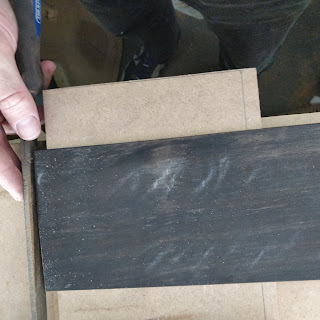Here's the headstock from last week, unclamped.
The eagle eye'd will notice that it's currently impossible to access the adjusting head of the truss rod, so we need an access hole of some sort through the veneer. I drilled a small hole in the veneer through to the truss rod channel underneath, and gradually enlarged it with bigger drill bits:
Once covered, the adjuster hole will not be visible:
I then spent a little time finessing the edge of the new hole to smooth it out. This is good enough for now, I'll revisit when the guitar is finished sanded in a few months time:
The picture below illustrates the access when the truss rod is in position:
Next I moved onto shaping the headstock. I decided to make a template for the headstock from using my neck template. It was glued / taped to a piece of thick stock MDF:
And after a few minutes on the robosander, we have a finished template:
It's key to make sure this template is aligned properly - else you'll end up with a wonky head on the guitar. I spent a long time measuring and centring the template,
Even busting out the Frickin' Laser Beam to check it:
I could align the neck relative to the Frickin' Laser Beam, then align the headstock template so that the laser went straight down the middle of that as well:
The headstock template was glued, then screwed down to the headstock. The screws are located where the tuner's will go eventually, so the holes will not be seen. We took a trip to the robosander:
I left a lot of material on the neck blank to be removed by the robosander, and it was pretty slow going. I had a go with my other drill tool - the Microplane Rotary Shaper. It's a terrifying thing when up to speed. The robosander doesn't hurt too much if you accidentally scrape it, but this thing looks like it would tear out chunks:
It leaves chips rather than dust, which is nicer in the workshop:
And doesn't leave as smooth a finish. However, it removes a lot of material, quickly:
I switched back to the robosander, and finished off the headstock:
Here's the finished product:
And from the side:
There's a little more shaping needed on the top edge in the centre to match the LP style that I'm going for. The follower bearing on the sander lacks the resolution to shape them so I'll do those by hand later on.




















































